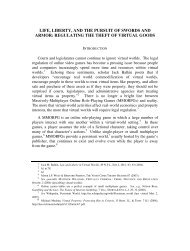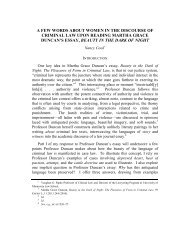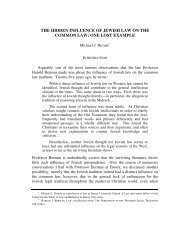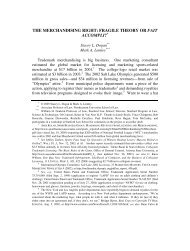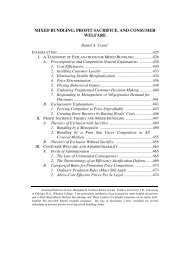Chimera and the Continuum of Humanity - Emory University School ...
Chimera and the Continuum of Humanity - Emory University School ...
Chimera and the Continuum of Humanity - Emory University School ...
You also want an ePaper? Increase the reach of your titles
YUMPU automatically turns print PDFs into web optimized ePapers that Google loves.
382 EMORY LAW JOURNAL [Vol. 55<br />
maximization, 259 while <strong>the</strong> biological requirement recognizes biological<br />
morality <strong>and</strong> <strong>the</strong> Kantian principle that <strong>the</strong>re is inherent value in human life. 260<br />
B. The Flaw in a Dichotomous Approach to Constitutional Personhood<br />
While it is incorrect to assert that chimera are never persons under <strong>the</strong><br />
Constitution, it is also incorrect to claim, as most commentators do, that <strong>the</strong>re<br />
is a distinct, identifiable point at which a chimera shifts from being a<br />
nonperson to being a person. 261 Regardless <strong>of</strong> <strong>the</strong>ir view on chimera<br />
personhood, most commentators presume that personhood must be an ei<strong>the</strong>r/or<br />
proposition. 262 As an example <strong>of</strong> a dichotomous approach to personhood in <strong>the</strong><br />
context <strong>of</strong> biotechnology, it has been proposed that “all <strong>and</strong> only species that<br />
are characterized by a capacity for [self-awareness] must be considered<br />
constitutional persons.” 263 This is an example <strong>of</strong> a reasonably flexible,<br />
cognitive approach to personhood that could include chimera exhibiting a<br />
fundamental trait <strong>of</strong> human cognition, self-awareness, or sentience. 264<br />
However, this analysis presupposes an identifiable point at which<br />
constitutional personhood kicks in. 265<br />
The line <strong>of</strong> demarcation between human <strong>and</strong> animal is being erased by<br />
chimera technology; what remains is a continuum with pure humans on one<br />
end, pure animals on <strong>the</strong> o<strong>the</strong>r, <strong>and</strong> various forms <strong>of</strong> chimera in between.<br />
Scientists can alter where <strong>the</strong>ir creations fall. 266 Thus, a bright line rule <strong>of</strong><br />
personhood is no longer appropriate. 267 The goal should not be to draw an<br />
259 See supra Part IV.<br />
260 See supra Part IV.<br />
261 See Fishman, supra note 215, at 478 (“To prevent <strong>the</strong> loss <strong>of</strong> legal rights <strong>of</strong> an altered human being<br />
who may no longer be found to be a member <strong>of</strong> <strong>the</strong> human species, it is imperative that <strong>the</strong> definition <strong>of</strong><br />
‘human being’ be exp<strong>and</strong>ed . . . it is better to err on <strong>the</strong> side <strong>of</strong> generosity ra<strong>the</strong>r than parsimony when<br />
depriving a being <strong>of</strong> his or her legal rights.”); Rivard, supra note 131, at 1509 (“[I]f <strong>the</strong> average, mature<br />
member <strong>of</strong> a species has <strong>the</strong> capacity for self-awareness, <strong>the</strong>n all members <strong>of</strong> that species are entitled to a<br />
rebuttable presumption <strong>of</strong> personhood. This <strong>the</strong>ory may be used to solve <strong>the</strong> problem <strong>of</strong> constitutional<br />
personhood for nonhuman species.”).<br />
262 A human-animal chimera is clearly partially biologically human. This highlights <strong>the</strong> fact that <strong>the</strong><br />
personhood question has been divorced from biological reality. Robert & Baylis, supra note 43, at 7–9.<br />
263 Rivard, supra note 131, at 1488.<br />
264 Id.<br />
265 This analysis also presupposes identifiable species lines, a concept that loses meaning when different<br />
species are combined in a chimera. This problem could be avoided however by replacing a species by species<br />
approach with a chimera by chimera approach.<br />
266 Weiss, supra note 18.<br />
267 See Magnani, supra note 35, at 449–50 (“[I]t is probably safe to say that any organism composed <strong>of</strong><br />
over 50% human genetic material would be considered human. From a common sense st<strong>and</strong>point, this<br />
st<strong>and</strong>ard seems reasonable enough, but it is somewhat simplistic <strong>and</strong> artificial.”).





